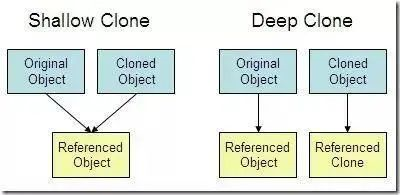Apache BeanUtils与Spring BeanUtils性能比较
在我们实际项目开发过程中,我们经常需要将不同的两个对象实例进行属性复制,从而基于源对象的属性信息进行后续操作,而不改变源对象的属性信息,比如DTO数据传输对象和数据对象DO,我们需要将DO对象进行属性复制到DTO,但是对象格式又不一样,所以我们需要编写映射代码将对象中的属性值从一种类型转换成另一种类型。
对象拷贝
在具体介绍两种 BeanUtils 之前,先来补充一些基础知识。它们两种工具本质上就是对象拷贝工具,而对象拷贝又分为深拷贝和浅拷贝,下面进行详细解释。
什么是浅拷贝和深拷贝
在Java中,除了 基本数据类型之外,还存在 类的实例对象这个引用数据类型,而一般使用 “=”号做赋值操作的时候,对于基本数据类型,实际上是拷贝的它的值,但是对于对象而言,其实赋值的只是这个对象的引用,将原对象的引用传递过去,他们实际还是指向的同一个对象。而浅拷贝和深拷贝就是在这个基础上做的区分,如果在拷贝这个对象的时候,只对基本数据类型进行了拷贝,而对引用数据类型只是进行引用的传递,而没有真实的创建一个新的对象,则认为是浅拷贝。反之,在对引用数据类型进行拷贝的时候,创建了一个新的对象,并且复制其内的成员变量,则认为是深拷贝。
简单来说:
- 浅拷贝:对基本数据类型进行值传递,对引用数据类型进行引用传递般的拷贝,此为浅拷贝
- 深拷贝:对基本数据类型进行值传递,对引用数据类型,创建一个新的对象,并复制其内容,此为深拷贝。

BeanUtils
前面简单讲了一下对象拷贝的一些知识,下面就来具体看下两种 BeanUtils 工具
Apache 的 BeanUtils
首先来看一个非常简单的BeanUtils的例子
publicclass PersonSource {
private Integer id;
private String username;
private String password;
private Integer age;
// getters/setters omiited
}
publicclass PersonDest {
private Integer id;
private String username;
private Integer age;
// getters/setters omiited
}
publicclass TestApacheBeanUtils {
public static void main(String[] args) throws InvocationTargetException, IllegalAccessException {
//下面只是用于单独测试
PersonSource personSource = new PersonSource(1, "pjmike", "12345", 21);
PersonDest personDest = new PersonDest();
BeanUtils.copyProperties(personDest,personSource);
System.out.println("persondest: "+personDest);
}
}
persondest: PersonDest{id=1, username='pjmike', age=21}
从上面的例子可以看出,对象拷贝非常简单,BeanUtils最常用的方法就是:
//将源对象中的值拷贝到目标对象//将源对象中的值拷贝到目标对象
public static void copyProperties(Object dest, Object orig) throws IllegalAccessException, InvocationTargetException {
BeanUtilsBean.getInstance().copyProperties(dest, orig);
}
默认情况下,使用org.apache.commons.beanutils.BeanUtils对复杂对象的复制是引用,这是一种浅拷贝
关注公众号程序员小乐回复关键字“offer”获取算法面试题和答案。
但是由于 Apache下的BeanUtils对象拷贝性能太差,不建议使用,而且在阿里巴巴Java开发规约插件上也明确指出:
Ali-Check | 避免用Apache Beanutils进行属性的copy。
commons-beantutils 对于对象拷贝加了很多的检验,包括类型的转换,甚至还会检验对象所属的类的可访问性,可谓相当复杂,这也造就了它的差劲的性能,具体实现代码如下:
public void copyProperties(final Object dest, final Object orig)
throws IllegalAccessException, InvocationTargetException {
// Validate existence of the specified beans
if (dest == null) {
thrownew IllegalArgumentException
("No destination bean specified");
}
if (orig == null) {
thrownew IllegalArgumentException("No origin bean specified");
}
if (log.isDebugEnabled()) {
log.debug("BeanUtils.copyProperties(" + dest + ", " +
orig + ")");
}
// Copy the properties, converting as necessary
if (orig instanceof DynaBean) {
final DynaProperty[] origDescriptors =
((DynaBean) orig).getDynaClass().getDynaProperties();
for (DynaProperty origDescriptor : origDescriptors) {
final String name = origDescriptor.getName();
// Need to check isReadable() for WrapDynaBean
// (see Jira issue# BEANUTILS-61)
if (getPropertyUtils().isReadable(orig, name) &&
getPropertyUtils().isWriteable(dest, name)) {
final Object value = ((DynaBean) orig).get(name);
copyProperty(dest, name, value);
}
}
} elseif (orig instanceof Map) {
@SuppressWarnings("unchecked")
final
// Map properties are always of type <String, Object>
Map<String, Object> propMap = (Map<String, Object>) orig;
for (final Map.Entry<String, Object> entry : propMap.entrySet()) {
final String name = entry.getKey();
if (getPropertyUtils().isWriteable(dest, name)) {
copyProperty(dest, name, entry.getValue());
}
}
} else/* if (orig is a standard JavaBean) */ {
final PropertyDescriptor[] origDescriptors =
getPropertyUtils().getPropertyDescriptors(orig);
for (PropertyDescriptor origDescriptor : origDescriptors) {
final String name = origDescriptor.getName();
if ("class".equals(name)) {
continue; // No point in trying to set an object's class
}
if (getPropertyUtils().isReadable(orig, name) &&
getPropertyUtils().isWriteable(dest, name)) {
try {
final Object value =
getPropertyUtils().getSimpleProperty(orig, name);
copyProperty(dest, name, value);
} catch (final NoSuchMethodException e) {
// Should not happen
}
}
}
}
}
Spring 的 BeanUtils
使用spring的BeanUtils进行对象拷贝:
publicclass TestSpringBeanUtils {
public static void main(String[] args) throws InvocationTargetException, IllegalAccessException {
//下面只是用于单独测试
PersonSource personSource = new PersonSource(1, "pjmike", "12345", 21);
PersonDest personDest = new PersonDest();
BeanUtils.copyProperties(personSource,personDest);
System.out.println("persondest: "+personDest);
}
}
Spring下的BeanUtils也是使用 copyProperties方法进行拷贝,只不过它的实现方式非常简单,就是对两个对象中相同名字的属性进行简单的get/set,仅检查属性的可访问性。具体实现如下:
private static void copyProperties(Object source, Object target, @Nullable Class<?> editable,
@Nullable String... ignoreProperties) throws BeansException {
Assert.notNull(source, "Source must not be null");
Assert.notNull(target, "Target must not be null");
Class<?> actualEditable = target.getClass();
if (editable != null) {
if (!editable.isInstance(target)) {
throw new IllegalArgumentException("Target class [" + target.getClass().getName() +
"] not assignable to Editable class [" + editable.getName() + "]");
}
actualEditable = editable;
}
PropertyDescriptor[] targetPds = getPropertyDescriptors(actualEditable);
List<String> ignoreList = (ignoreProperties != null ? Arrays.asList(ignoreProperties) : null);
for (PropertyDescriptor targetPd : targetPds) {
Method writeMethod = targetPd.getWriteMethod();
if (writeMethod != null && (ignoreList == null || !ignoreList.contains(targetPd.getName()))) {
PropertyDescriptor sourcePd = getPropertyDescriptor(source.getClass(), targetPd.getName());
if (sourcePd != null) {
Method readMethod = sourcePd.getReadMethod();
if (readMethod != null &&
ClassUtils.isAssignable(writeMethod.getParameterTypes()[0], readMethod.getReturnType())) {
try {
if (!Modifier.isPublic(readMethod.getDeclaringClass().getModifiers())) {
readMethod.setAccessible(true);
}
Object value = readMethod.invoke(source);
if (!Modifier.isPublic(writeMethod.getDeclaringClass().getModifiers())) {
writeMethod.setAccessible(true);
}
writeMethod.invoke(target, value);
}
catch (Throwable ex) {
throw new FatalBeanException(
"Could not copy property '" + targetPd.getName() + "' from source to target", ex);
}
}
}
}
}
}
可以看到,成员变量赋值是基于目标对象的成员列表,并且会跳过ignore的以及在源对象中不存在,所以这个方法是安全的,不会因为两个对象之间的结构差异导致错误,但是必须保证同名的两个成员变量类型相同。
小结
以上简要的分析两种BeanUtils,因为Apache下的BeanUtils性能较差,不建议使用,可以使用 Spring的BeanUtils ,或者使用其他拷贝框架,比如:Dozer、ModelMapper
Apache BeanUtils与Spring BeanUtils性能比较的更多相关文章
- Bean映射工具之Apache BeanUtils VS Spring BeanUtils
背景 在我们实际项目开发过程中,我们经常需要将不同的两个对象实例进行属性复制,从而基于源对象的属性信息进行后续操作,而不改变源对象的属性信息,比如DTO数据传输对象和数据对象DO,我们需要将DO对象进 ...
- 基于 asm 实现比 spring BeanUtils 性能更好的属性拷贝框架
Bean-Mapping 日常开发中经常需要将一个对象的属性,赋值到另一个对象中. 常见的工具有很多,但都多少不够简洁,要么不够强大. 我们经常使用的 Spring BeanUtils 性能较好,但是 ...
- spring: beanutils.copyproperties将一个对象的数据塞入到另一个对象中(合并对象)
spring: beanutils.copyproperties将一个对象的数据塞入到另一个对象中(合并对象) 它的出现原因: BeanUtils提供对Java反射和自省API的包装.其主要目的是利用 ...
- Spring Boot 性能优化
spring 框架给企业软件开发者提供了常见问题的通用解决方案,包括那些在未来开发中没有意识到的问题.但是,它构建的 J2EE 项目变得越来越臃肿,逐渐被 Spring Boot 所替代.Spring ...
- apache FtpServer 整合spring部署
我们在项目中可能会出现这样的需求,使用ftp上传很大的文件后对需要对文件进行相应的逻辑处理,这时我们可以使用apache ftpServer来处理这段逻辑,只要我们做相应的部署和编写我们的逻辑代码,这 ...
- 使用Apache CXF和Spring集成创建Web Service(zz)
使用Apache CXF和Spring集成创建Web Service 您的评价: 还行 收藏该经验 1.创建HelloWorld 接口类 查看源码 打印? 1 package ...
- [转载]JDBC/Spring/MyBatis性能比较
原文地址:JDBC/Spring/MyBatis性能比较作者:tom_lt 测试目的: 比较JDBC,SpringJdbc和MyBatis的性能. 测试用例: 1. 查询:查询一张10000条数据 ...
- apache shiro整合spring(一)
apache shiro整合spring 将shiro配置文件整合到spring体系中 方式一:直接在spring的配置文件中import shiro的配置文件 方式二:直接在web.xml中配置sh ...
- Apache、nginx 、lighttpd性能比较
Apache.nginx .lighttpd性能比较 1. web服务器简介 1. lighttpd Lighttpd是一个德国人领导的开源软件,其根本的目的是提供一个专门针对高性能网站,安全.快速. ...
随机推荐
- Kubernetes(K8s)基础概念 —— 凿壁偷光
Kubernetes(K8s)基础概念 -- 凿壁偷光 K8s是什么:全称 kubernetes (k12345678s) 作用:用于自动部署,扩展和管理"容器化应用程序"的 ...
- 论文解读(IDEC)《Improved Deep Embedded Clustering with Local Structure Preservation》
Paper Information Title:<Improved Deep Embedded Clustering with Local Structure Preservation>A ...
- python多版本切换
环境:Macbook MacOS自带的python2.7,在命令行中输入python后会显示2.7版本 如何切换成新版本? 一.修改用户配置环境变量~/.bash_profile 确定新版本的安装位置 ...
- 02 HTML标签
2. HTML标签 1. HTML简介 用户使用浏览器打开网页看到结果的过程就是:浏览器将服务端的文本文件(即网页文件)内容下载到本地,然后打开显示的过程. 而文本文件的文档结构只有空格和黄航两种组织 ...
- LinuxCPU性能工具总结
一.根据性能指标找工具 二.根据工具查性能指标
- MyBatis功能点二:从责任链设计模式的角度理解插件实现技术
MyBatis允许对其四大组件(Executor,StatementHandler,ParameterHandler, ResultSetHandler)进行增强处理.在创建四大组件对象的时候 1.每 ...
- [LeetCode]1221. 分割平衡字符串
在一个「平衡字符串」中,'L' 和 'R' 字符的数量是相同的. 给出一个平衡字符串 s,请你将它分割成尽可能多的平衡字符串. 返回可以通过分割得到的平衡字符串的最大数量. 示例 1: 输入:s = ...
- 快速搭建一套k8s集群环境
参考官网 kubeadm是官方提供的快速搭建k8s集群的开源工具,对于非运维人员学习k8s,kubeadm方式安装相对更简单. kubeadm创建一个集群:https://kubernetes.io/ ...
- 解决方案:ipv4地址手动设置之后关掉推出再打开就没了(静态Ip设置好之后又自动变动态IP)
解决方案:ipv4地址手动设置之后关掉推出再打开就没了(静态Ip设置好之后又自动变动态IP) 1.情况说明:修改好IP,关掉窗口后,又变成 自动获取IP (如图二) 2.解决方案: 1)调出 服务和应 ...
- 【Java分享客栈】我有一个朋友,和前端工程师联调接口被狠狠鄙视了一番。
前言 我有一个朋友,昨天和前端工程师联调一个接口,然后被狠狠鄙视了一番. 大家知道,自从前后端分离以后,像我一样一直以Java工程师为傲而自居的码圣们就砍掉了一半脊梁,从此被贴上了"Java ...
